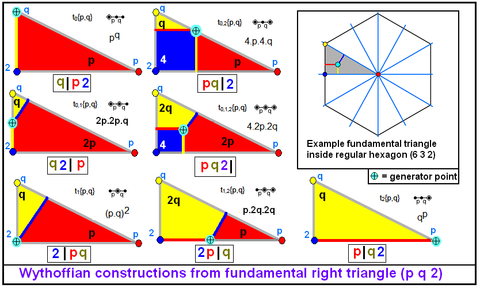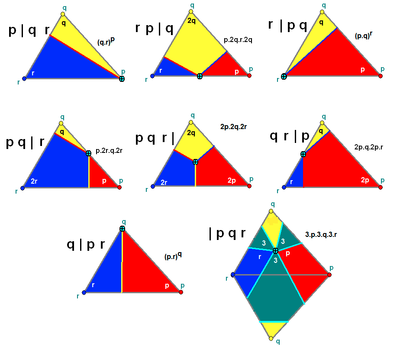Wythoff symbol

In geometry, a Wythoff symbol is a short-hand notation, created by mathematician Willem Abraham Wythoff, for naming the regular and semiregular polyhedra using a kaleidoscopic construction, by representing them as tilings on the surface of a sphere, Euclidean plane, or hyperbolic plane.
The Wythoff symbol gives 3 numbers p,q,r and a positional vertical bar (|) which separate the numbers before or after it. Each number represents the order of mirrors at a vertex of the fundamental triangle.
Each symbol represents one uniform polyhedron or tiling, although the same tiling/polyhedron can have different Wythoff symbols from different symmetry generators. For example, the regular cube can be represented by 3 | 4 2 with Oh symmetry, and 2 4 | 2 as a square prism with 2 colors and D4h symmetry, as well as 2 2 2 | with 3 colors and D2h symmetry.
Summary table

There are 7 generator points with each set of p,q,r: (And a few special forms)
| General | Right triangle (r=2) | |||
|---|---|---|---|---|
| Description | Wythoff symbol |
Vertex configuration |
Wythoff symbol |
Vertex configuration |
| regular and quasiregular |
q | p r | (p.r)q | q | p 2 | pq |
| p | q r | (q.r)p | p | q 2 | qp | |
| r | p q | (q.p)r | 2 | p q | (q.p)2 | |
| truncated and expanded |
q r | p | q.2p.r.2p | q 2 | p | q.2p.2p |
| p r | q | p.2q.r.2q | p 2 | q | p.2q.2q | |
| p q | r | 2r.q.2r.p | p q | 2 | 4.q.4.p | |
| even-faced | p q r | | 2r.2q.2p | p q 2 | | 4.2q.2p |
| p q (r s) | | 2p.2q.-2p.-2q | p 2 (r s) | | 2p.4.-2p.4/3 | |
| snub | | p q r | 3.r.3.q.3.p | | p q 2 | 3.3.q.3.p |
| | p q r s | (4.p.4.q.4.r.4.s)/2 | - | - | |
There are three special cases:
- p q (r s) | - This is a mixture of p q r | and p q s |.
- | p q r - Snub forms (alternated) are give this otherwise unused symbol.
- | p q r s - A unique snub form for U75 that isn't Wythoff constructable.
Description
The p,q,r represent the shape of the fundamental triangle fo the symmetry, specifically each number is the number of reflectional mirrors that exist at each vertex. On the sphere there are 3 main symmetry types: (3 3 2), (4 3 2), (5 3 2), and one infinite family (p 2 2), for any p=2,3,... (All simple families have one right angle and so r=2)
The position of the vertical bar in the symbol is used to imply a specific forms (a categorical position of the generator point) within the fundamental triangle. The generator point can either be on or off each mirror, activated or not. This distinction creates 8 (23) possible forms, neglecting one where the generator point is on all the mirrors.
In this notation the mirrors are labeled by the reflection-order of the opposite vertex. The p,q,r values are listed before the bar if the corresponding mirror is active.
The one impossible symbol | p q r, which implies the the generator point is on all mirrors which is only possible if the triangle is generated to a point. This unused symbol is reassigned to mean something different. This symbols represents the case where all mirrors are active, but odd-numbered reflected images are ignored. This creates a rotational symmetry results.
This symbol is functionally similar to the more general Coxeter-Dynkin diagram which shows a triangle marked as p, q, r on the edges, and circles the nodes, representing the mirrors to imply whether the generator point was touching that mirror. (The Coxeter-Dynkin diagram is show as a linear graph when r=2 since there's no interacting reflections across a right angle.)
Symmetry triangles
There are 4 symmetry classes of reflection on the sphere, and two for the Euclidean plane, and infinitely many for the hyperbolic plane, the first:
- (p 2 2) dihedral symmetry p=2,3,4... (Order 4p)
- (3 3 2) tetrahedral symmetry (Order 24)
- (4 3 2) octahedral symmetry (Order 48)
- (5 3 2) icosahedral symmetry (Order 120)
- (4 4 2) - *442 symmetry - 45-45-90 triangle (Includes square domain (2 2 2 2))
- (3 3 3) - *333 symmetry - 60-60-60 triangle
- (6 3 2) - *632 symmetry - 30-60-90 triangle
- (7 3 2) - *732 symmetry (Hyperbolic plane)
| Dihedral spherical | Spherical | |||
|---|---|---|---|---|
| D2h | D3h | Td | Oh | Ih |
| *222 | *322 | *332 | *432 | *532 |
 (2 2 2) |
 (3 2 2) |
 ( 3 3 2) |
 (4 3 2) |
 (5 3 2) |
The above symmetry groups only includes the integer solutions on the sphere. The list of Schwarz triangles includes rational numbers, and determine the full set of solutions of uniform polyhedrons.
| Euclidean plane | Hyperbolic | ||
|---|---|---|---|
| p4m | p3m | p6m | |
| *442 | *333 | *632 | *732 |
 (4 4 2) |
 (3 3 3) |
 (6 3 2) |
 (7 3 2) |
In the tilings above, each triangle is a fundamental domain, colored by even and odd reflections.
Summary spherical and plane tilings
An selection of tilings created by the Wythoff construction are given below.
Spherical tilings (r=2)
| (p q 2) | Fund. triangle |
Parent | Truncated | Rectified | Bitruncated | Birectified (dual) |
Cantellated | Omnitruncated (Cantitruncated) |
Snub |
|---|---|---|---|---|---|---|---|---|---|
| Wythoff symbol | q | p 2 | 2 q | p | 2 | p q | 2 p | q | p | q 2 | p q | 2 | p q 2 | | | p q 2 | |
| Schläfli symbol | t0{p,q} | t0,1{p,q} | t1{p,q} | t1,2{p,q} | t2{p,q} | t0,2{p,q} | t0,1,2{p,q} | s{p,q} | |
| Coxeter-Dynkin diagram | |||||||||
| Vertex figure | pq | (q.2p.2p) | (p.q.p.q) | (p.2q.2q) | qp | (p.4.q.4) | (4.2p.2q) | (3.3.p.3.q) | |
| Tetrahedral (3 3 2) |

|
 {3,3} |
File:Uniform tiling 332-t01.png (3.6.6) |
File:Uniform tiling 332-t1.png (3.3a.3.3a) |
 (3.6.6) |
 {3,3} |
 (3a.4.3b.4) |
 (4.6a.6b) |
 (3.3.3a.3.3b) |
| Octahedral (4 3 2) |

|
 {4,3} |
 (3.8.8) |
 (3.4.3.4) |
 (4.6.6) |
 {3,4} |
 (3.4.4a.4) |
 (4.6.8) |
 (3.3.3a.3.4) |
| Icosahedral (5 3 2) |

|
 {5,3} |
 (3.10.10) |
 (3.5.3.5) |
 (5.6.6) |
 {3,5} |
 (3.4.5.4) |
 (4.6.10) |
 (3.3.3a.3.5) |
Planar tilings (r=2)
One representative hyperbolic tiling is given, and shown as a Poincaré disk projection.
| (p q 2) | Fund. triangle |
Parent | Truncated | Rectified | Bitruncated | Birectified (dual) |
Cantellated | Omnitruncated (Cantitruncated) |
Snub |
|---|---|---|---|---|---|---|---|---|---|
| Wythoff symbol | q | p 2 | 2 q | p | 2 | p q | 2 p | q | p | q 2 | p q | 2 | p q 2 | | | p q 2 | |
| Schläfli symbol | t0{p,q} | t0,1{p,q} | t1{p,q} | t1,2{p,q} | t2{p,q} | t0,2{p,q} | t0,1,2{p,q} | s{p,q} | |
| Coxeter-Dynkin diagram | |||||||||
| Square tiling (4 4 2) |

|
 {4,4} |
 4.8.8 |
 4.4a.4.4a |
 4.8.8 |
 {4,4} |
 4.4a.4b.4a |
 4.8.8 |
 3.3.4a.3.4b |
| Hexagonal tiling (6 3 2) |

|
 {6,3} |
 3.12.12 |
 3.6.3.6 |
 6.6.6 |
 {3,6} |
 3.4.6.4 |
 4.6.12 |
 3.3.3.3.6 |
| (Hyperbolic plane) (7 3 2) |
 {7,3} |
 3.14.14 |
 3.7.3.7 |
 7.6.6 |
 {3,7} |
 3.4.7.4 |
 4.6.14 |
 3.3.3.3.7 |
Planar tilings (r>2)
The Coxeter-Dynkin diagram is given in a linear form, although it is actually a triangle, with the trailing segment r connecting to the first node.
| Wythoff symbol (p q r) |
Fund. triangle |
q | p r | r q | p | r | p q | r p | q | p | q r | p q | r | p q r | | | p q r |
|---|---|---|---|---|---|---|---|---|---|
| Coxeter-Dynkin diagram | |||||||||
| Triangular (3 3 3) |

|
 (3.3)3 |
 3a.6.3b.6 |
 (3.3)3 |
 3a.6.3b.6 |
 (3.3)3 |
 3a.6.3b.6 |
 6a.6b.6c |
 3.3a.3.3b.3.3c |
Overlapping spherical tilings (r=2)
Tilings are shown as polyhedra. Some of the forms are degenerate, given with brackets for vertex figures, with overlapping edges or verices.
| (p q 2) | Fund. triangle |
Parent | Truncated | Rectified | Bitruncated | Birectified (dual) |
Cantellated | Omnitruncated (Cantitruncated) |
Snub |
|---|---|---|---|---|---|---|---|---|---|
| Wythoff symbol | q | p 2 | 2 q | p | 2 | p q | 2 p | q | p | q 2 | p q | 2 | p q 2 | | | p q 2 | |
| Schläfli symbol | t0{p,q} | t0,1{p,q} | t1{p,q} | t1,2{p,q} | t2{p,q} | t0,2{p,q} | t0,1,2{p,q} | s{p,q} | |
| Coxeter-Dynkin diagram | |||||||||
| Icosahedral 5/2-3-2 |
 {3,5/2} |
 (5/2.6.6) |
 (3.5/2)2 |
 [3.10/2.10/2] |
 {5/2,3} |
 [3.4.5/2.4] |
 [4.10/2.6] |
 (3.3.3.3.5/2) | |
| Icosahedral 5-5/2-2 |
 {5,5/2} |
 (5/2.10.10) |
 (5/2.5)2 |
 [5.10/2.10/2] |
 {5/2,5} |
 (5/2.4.5.4) |
 [4.10/2.10] |
 (3.3.5/2.3.5) |
See also
References
- Coxeter Regular Polytopes, Third edition, (1973), Dover edition, ISBN 0-486-61480-8 (Chapter V: The Kaleidoscope, Section: 5.7 Wythoff's construction)
- Coxeter The Beauty of Geometry: Twelve Essays, Dover Publications, 1999, ISBN 0-486-40919-8 (Chapter 3: Wythoff's Construction for Uniform Polytopes)
- Coxeter, Longuet-Higgins, Miller, Uniform polyhedra, Phil. Trans. 1954, 246 A, 401-50.
- Wenninger, Magnus (1974). Polyhedron Models. Cambridge University Press. ISBN 0-521-09859-9. pp. 9-10.
External links
- Weisstein, Eric W. "Wythoff symbol". MathWorld.
- The Wythoff symbol
- Wythoff symbol
- Displays Uniform Polyhedra using Wythoff's construction method
- Description of Wythoff Constructions
- KaleidoTile 3 Free educational software for Windows by Jeffrey Weeks that generated many of the images on the page.
